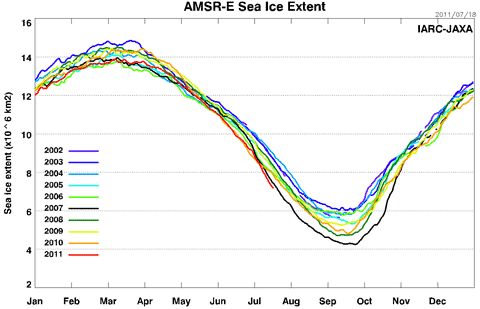Sunshine is pouring down on the Arctic, and the high summer melting season is well under way. This photograph from NASA’s Earth Observatory shows crew from the US Coast Guard cutter Healey collecting a supply drop canister from melt ponds on the surface of the ice in the Beaufort Sea during the current Icescape exercise. Which is a good looking way to introduce a rather serious graph…
That’s the Japanese version of the current sea ice extent as measured by satellite, and it shows that up to July 18 the ice was melting faster than in 2007 — the year that set the record for the summer minimum extent. Jeff Masters explained why July might be interesting in a post a couple of weeks ago, and today the National Snow and Ice Data Centre in the US released an update on the summer melt so far:
Arctic sea ice extent declined rapidly through the first two weeks of July, at a rate averaging nearly 120,000 square kilometers (46,000 square miles) per day. Ice extent is now tracking below the year 2007, which saw the record minimum September extent.
The next six weeks will determine whether we see a new record. The experts involved in the ARCUS “sea ice outlook” forecasting exercise are still being cautious, with only three teams in the latest round calling for a new record. But only two projections (one of them being based on a vote at µWatts) call for a higher minimum than last summer.
As ever, the best way to follow the summer melt is to visit Neven’s excellent Arctic Sea Ice Blog, and in particular his excellent single page overview of just about every graph, chart and webcam covering the region. Here’s what NOAA’s North Pole webcam was showing at the time of writing:

Whatever happens in September, there’s still lots of interest to look out for. Will the NW Passage and the Northern Route above Russia both open? (My money is on yes, and quite soon). And if I had a bet on this year’s minimum, I’d say the chances of a new record were looking pretty good. Although “good” is not the right word to use for a rapid change at one end of the planet that could have very significant consequences for the climate of the northern hemisphere. We do indeed live in interesting times…
[Reg Presley is reputed to have made £1 million in royalties from the WWW cover, and to have spent most of it on investigating “crop circles”.]



Yeah, I reckon there is a very good chance of a record low this year. As well as a marked shift to neutral ENSO conditions, there is anecdotal evidence that China has started trying to clear the air of aerosol pollution, which could lead to a fairly swift jump in temps. All this suggests that we are going to see some odd things happening in the next few months.
Although I’m sure that R2 will be along soon to reassure us that it is all just natural variation, nothing to worry about, and certainly no reason to introduce any nasty new taxes…
There’s to be a routinely updated discussion post (e.g. a new JAXA graph, among others, will be posted each day) over at RealClimate on this here.